Dracaena: features and origin, planting and care
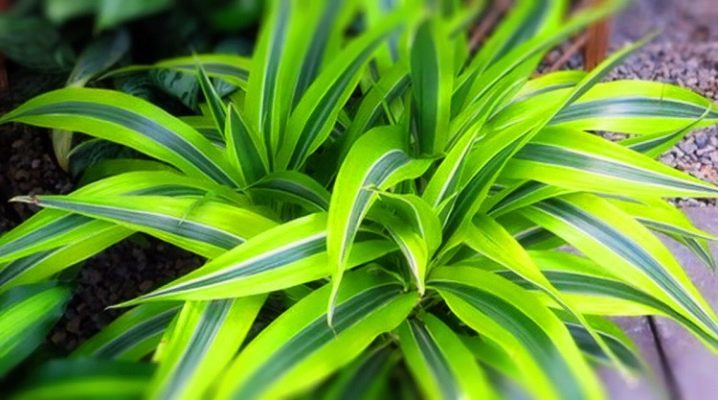
Dracaena can be called one of the most common indoor plants. This representative of the flora is characterized by beauty and ease of care. Dracaena has several varieties, when growing, it is worth creating optimal conditions for their growth and development in order to get a wonderful living decoration in the room.
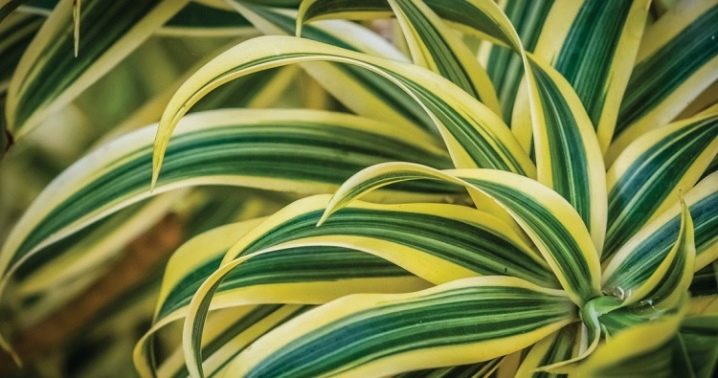
Origin story
Dracaena is called the tree of happiness; territories such as Africa and South Asia are considered its homeland. There is an opinion that this representative of the flora is an individual from the Agvaceae, Butcher's family, but more recently it was recognized as an individual of the asparagus family. They brought a tree from the Congo. Depending on the place of growth and the variety of dracaena, there are different sizes.
This plant is native to warm countries, so it prefers greenhouse growing conditions. Exploring the history of the origin of dracaena, we can conclude that it has nothing to do with palm trees, except for the vernal resemblance. But it is sometimes called a room palm.
According to legend, this majestic tree grew in the place where the terrible dragon was defeated, after which the earth absorbed his blood. Therefore, these streaks appear on the dracaena in the form of bright red spots along the trunk. In the place of the crack in the trunk, a resinous substance is released - it is a gum with healing properties. Dracaena is an exotic fauna native to the tropics. In the most favorable climate, it can grow up to 20 meters.
In indoor conditions, the "dragon tree" is much smaller, but it has the ability to become a decorative decoration of any home.
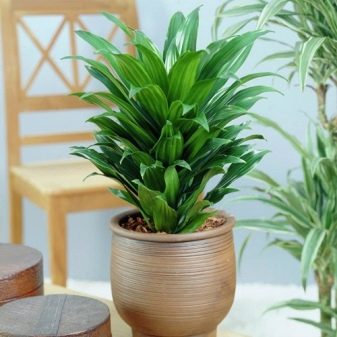
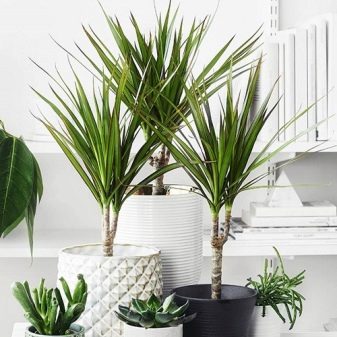
Plant features
Dracaena is a houseplant that belongs to the asparagus family. This is one of the varieties of indoor flowers. His description suggests that the plant looks like a palm bush. In height, indoor dracaena can be of various sizes, the tallest shrubs are purchased for office space. To decorate your home, you can acquire an individual 0.5 meters high. This upright type tree has dense and spreading foliage, which can have different colors and widths.
Often the trunks of the "dragon tree" resemble bamboo. The flowering of the plant is characterized by the appearance of white or green flowers that gather in inflorescences - panicles. Dracaena is called the tree of happiness, which is absolutely not poisonous. The tree accumulates energy and creates a positive atmosphere in the home, which is why it only benefits those who live next to it. Popular signs that are associated with it:
- dracaena helps to improve the energy of the room, as well as create a positive emotional climate within the walls of the house;
- the plant is quite sensitive to negativity and bad thoughts, therefore it withers with an unfavorable emotional atmosphere;
- This representative of the flora is recommended to be raised by people who are lonely and wish to start a family.

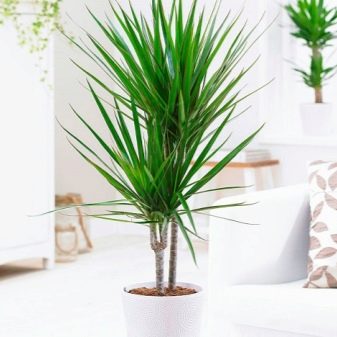
Views
The indoor palm is characterized by a wide species diversity, each type of which has a special difference from the others. The tree can be large or small, broad-leaved and variegated. The main types of "dragon tree".
- "Deremskaya". In the wild, the tree can reach a height of 5 m. This species is characterized by lanceolate narrow foliage of a dark green color. The length of the sheet does not exceed 150 cm.A three-meter tree in a home environment is characterized by the concentration of foliage in the upper part. Young leaves grow upward, with age they are able to fall lower.
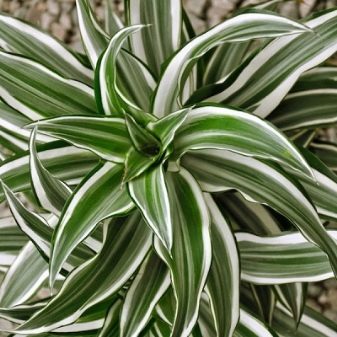

- "Fragrant". This type of dracaena is capable of blooming in natural conditions. At the same time, a pleasant fragrant smell emanates from it. The arrangement of flowers is concentrated on a 1 meter peduncle. They have a pompom shape, but, unfortunately, they are not capable of flowering at home. Dracaena "Fragrant" is a flower with wide leaves that looks very beautiful on thick, unstable trunks.
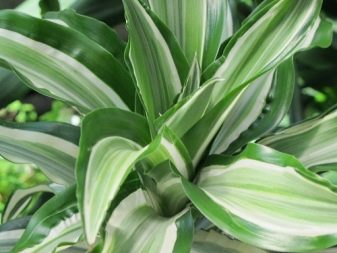
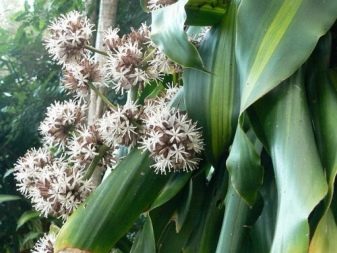
- "Bordered". Often this type of plant is common in a residential or workroom, it can reach a height of about 3 meters, it is also characterized by dark green foliage, which reaches 0.7 meters in length. Marginanta, as this species is called in another way, has the appearance of a slender tree, which is characterized by a trunk without branches, as well as a top with sharp foliage.
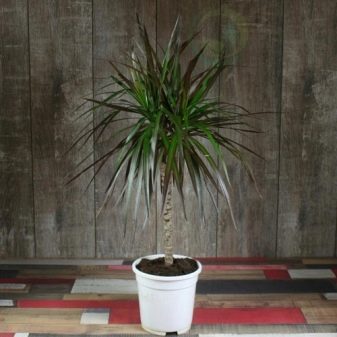
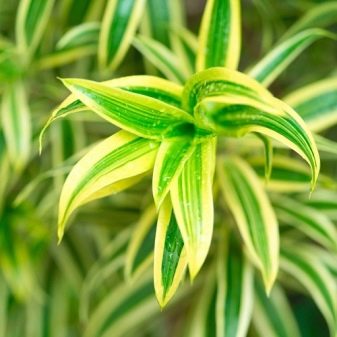
- "Canadian" or "dragon tree". In nature, it is common in Africa and the Canary Islands. The indoor flower reaches a height of 1.5 meters. Dracaena foliage is bluish-colored and has thorns, their length usually does not exceed 0.6 meters.
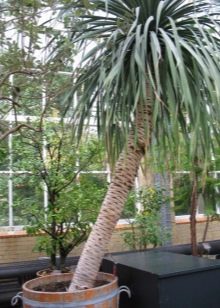
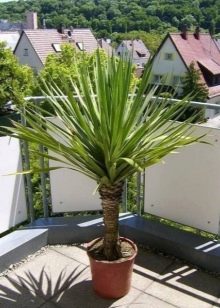
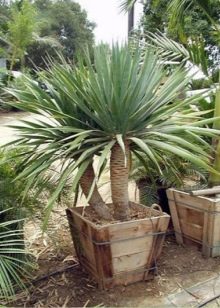
- Dracaena "wide" - This is a wide-stemmed type of tree, which is characterized by arched elongated foliage with a length of 1 meter and a width of 0.04 meters.
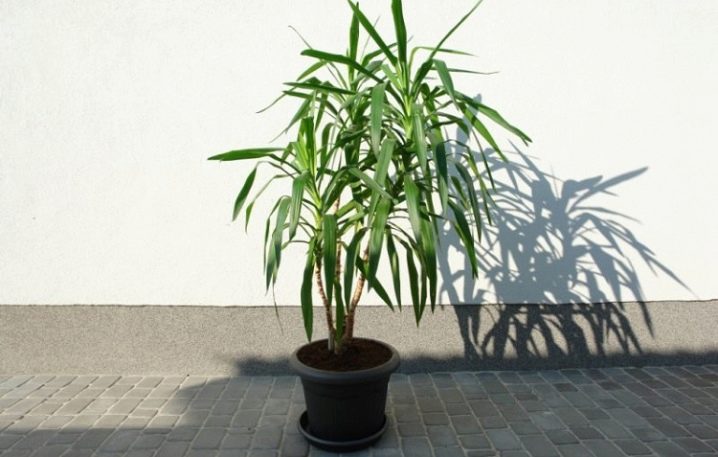
- Sandera. This species is short, characterized by a thin trunk and rich green foliage. The latter has an elongated shape, as well as a length of 0.2 meters and a width of 0.03 meters. The leaves are decorated with silvery stripes, some of them are very variegated. "Sandera" refers to non-capricious plants, it feels good on aqua soil.

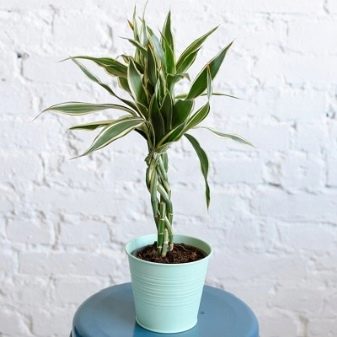
- "Runaway". Dracaena of this species belongs to evergreens, its height can reach 300 cm. Its leaves are green and covered with yellow spots.
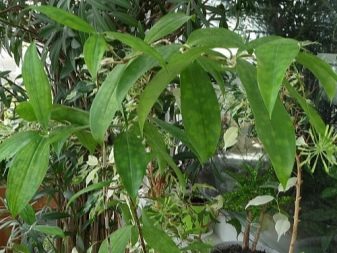
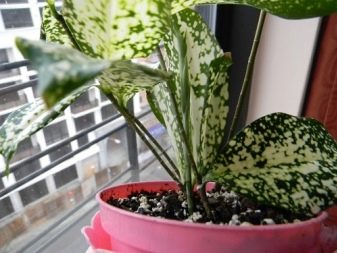
- "Bent back" Dracaena is characterized by high height, it can grow up to 500 cm. The tree can consist of several trunks of small thickness. The plant is covered with green foliage, which does not exceed 0.15 meters in length and is characterized by an elongated lanceolate shape.


How to care?
The indoor palm is loved by many flower growers. She not only does not create difficulties in growing, but also fits perfectly into the interior of an office and a residential building. This flower does not belong to the whimsical category, since it does not need special care. In order for the plant to be able to fully open up, it needs conditions that will resemble natural ones to the maximum.
Only in this case, the dracaena will grow rapidly, and will also delight its owners with wide bright foliage, as well as the splendor of the crown.
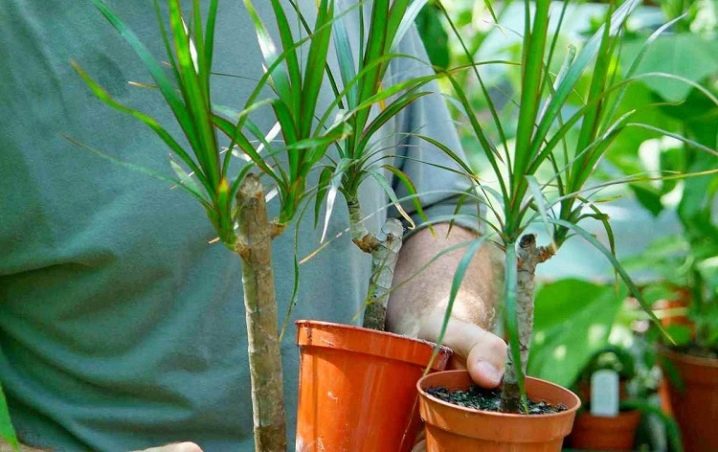
Temperature regime
Dracaena is an unpretentious representative of the flora, so even an inexperienced gardener can start growing it. This plant needs a moderate indoor temperature. In summer - + 18-25 degrees, in winter - at least 15 degrees. In the warm season, the dracaena should be periodically taken out into the street for airing, but at the same time not put it in a draft or near an open window.
In hot weather, it is better to water the flower additionally.
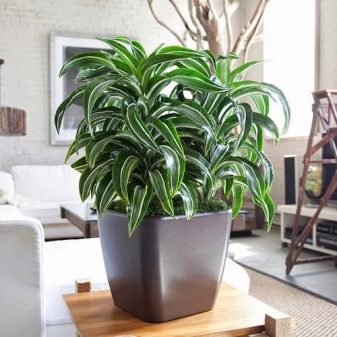
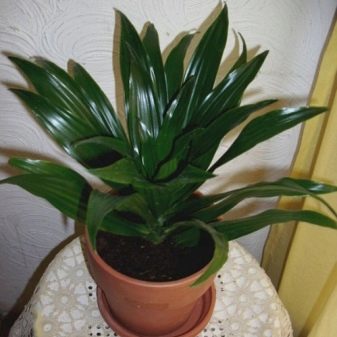
Humidity
Many of the dracaena species have a negative attitude towards dry air, therefore, they require constant spraying, regardless of the season. If you do not spray the plant twice a day, then its foliage may turn yellow. It is also worth carrying out constant rubbing of dracaena foliage with a damp cloth. Washing the tree with a shower is allowed.
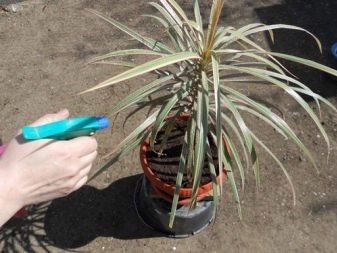

Lighting
The best place for the normal life of the dracaena will be a well-lit area or partial shade, but not direct sunlight. The indoor flower belongs to the thermophilic representatives, it loves moist air and diffused light. Species that have striped foliage favor bright lighting.
In the case of lighting, a balanced light balance is the best option. Rules for the location of the dracaena in the room.
- In the south or west room the flower does not need to be placed on the windowsill, as this can lead to drying and yellowing of the leaves. It is better to choose a place close to the window, but at the same time not close to the heating devices. If the window of the southern room overlooks a constant shadow, then the dragon tree will be comfortable on the windowsill.
- The northern room is not the most suitable option for the location of the flower.... But if there are no other options, then the pot should be placed on the windowsill close to the window, but it is better to abandon thick curtains. When the tree grows to 150 cm, it will need to be lowered to the floor.
- The eastern room is ideal for dracaena. This plant will be comfortable under oblique sunlight in such a room.
A young individual should be placed on a windowsill, and an adult on the floor.
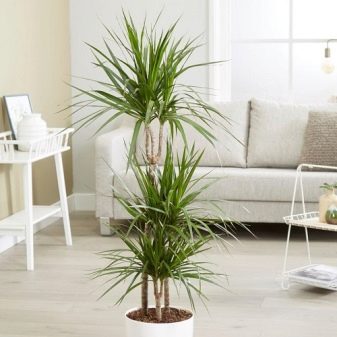
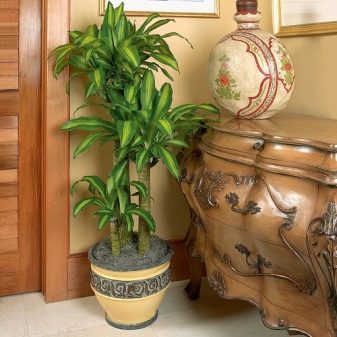
Top dressing
When feeding dracaena, you need to observe the regularity and balance of the fertilizers applied. If you want to feed the flower, it is worth remembering that it is better to do this in the summer period of the year. The regularity of feeding corresponds to the growth phases.
- From April to August this indoor flower grows intensively. To improve this process, it is necessary to feed it with complex fertilizers twice a month.
- From August to March dracaena stops growing, so a one-time feeding in 30 days will be enough for her.
The tree is quite demanding on the components of the fertilizer. An ideal feeding option will be a special complex for dracaena. It is as follows: sodium, phosphorus, potassium, minerals in a ratio of 3: 1: 3. If the dosage is exceeded, brown spots may form on it, and the green foliage will begin to die off.
By purchasing a specialized fertilizer, you can be sure of its safe effect on the plant.
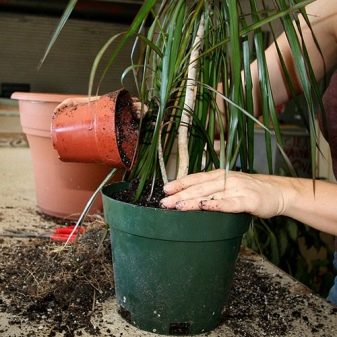
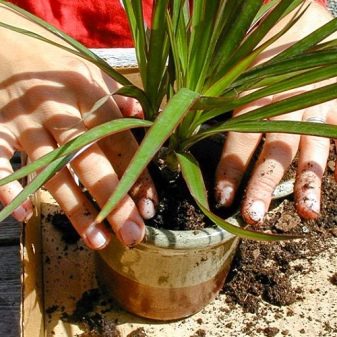
Watering
Irrigation for dracaena is a very important event, but this procedure must be carried out correctly. Do not be zealous, as this can lead to the development of fungal diseases. During the spring-summer active growth phase of the tree, it is worth watering abundantly once every 7 days. For this event, it is worth using settled water that has room temperature.
From the second half of autumn, the tree begins a dormant period, so the intensity of irrigation should be reduced and carried out once every 30 days. If the dracaena is located in the immediate vicinity of heating devices, it is necessary to water the flower twice a month, guided by the moisture of the soil.
Waterlogging and stagnant water are contraindicated for a plant of this type, therefore the dracaena pot must have high-quality drainage.
The most dangerous waterlogging is considered in the winter period of the year.


Transfer
It is better to transplant dracaena at the end of the winter period and at the beginning of the spring. At this time, the indoor palm will tolerate the transplant well, as it passes from the resting phase to active growth. It is necessary to carry out a transplant in such cases:
- the root system of the flower does not have enough space and it needs a larger pot;
- after purchasing a plant;
- with excessive irrigation of the tree, when root rot has occurred;
- if the quality of the soil has deteriorated and the flower grows poorly;
- with a planned transplant or excessive pest attack.
To transplant a tree well, you will need to prepare a pot of the right size, a drainage system, a substrate, a water spray, a cup of liquid, pruning shears or scissors for gardening.
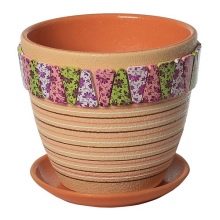

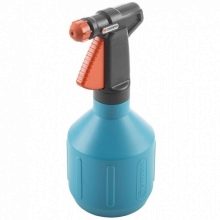
In order for the further growth and development of dracaena to be optimal, you will need to choose the right container. The pot must not only have an attractive appearance, but also meet the following requirements:
- have dimensions 2-3 centimeters larger in diameter than the previous one, since it will need to accommodate overgrown roots in it;
- a pair of holes should be present at the bottom, which helps to regulate the level of moisture;
- the pot should not be too large, since there is a possibility of moisture retention and the subsequent death of the plant;
- an adult tree should pick up a pot that has the shape of a glass.
After the pot is selected, you can start preparing the substrate, since it is he who plays the main role in the nutrition and growth of the dracaena. Growth of a "dragon tree" is possible on any substrate, but it is worth giving preference to a drained one, which has an acidity of 6-6.5 pH.
It is not recommended to use soil that was taken from the garden, as it may contain a large amount of salt.
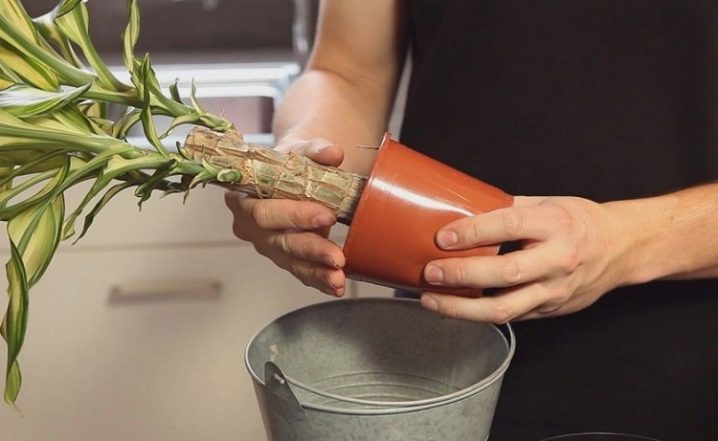
You can make the soil yourself or buy it. To prepare the substrate, you need leafy, sod land, compost and peat. The ratio of substances should be as follows: 2: 1: 1: 0.5. As drainage, you can use expanded clay balls, detailed bricks.
To carry out a dracaena transplant without harming it, you will first need to rinse the new pot with soapy water and clean water. Before the procedure "dragon tree" is not watered for three days, which contributes to the drying of the soil. To free the plant, it is necessary to tilt the dracaena upside down, patting the pot. It is worth removing the plant with a lump of soil.
The next step is to inspect the root system for damage. If there are any, it is necessary to trim them with a pruner.
After these procedures, the rhizome should be sprayed with plain water.
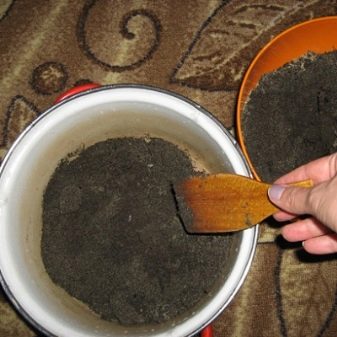

Thick drainage is laid out on the pot bottom. A soil layer is poured on top of it, and then dracaena is placed in the container. The roots of the plant should be covered with the substrate that remains. The soil near the stem needs careful compaction. At the end of the above procedures, the indoor palm must be watered.
When replanting a room palm, you should heed these recommendations.
- Do not bury the plant during transplanting. Otherwise, irrigation of the dracaena will be inconvenient, so it will be appropriate to leave the sides.
- The soil must be compacted. For this procedure, lightly tapping the pot on the table will be sufficient.
- You can plant a couple of dracaena in one container, but at the same time it is worth taking into account the size of the container.
After replanting, the "dragon tree" undergoes adaptation for 14 days. During this time, the formation of the root system of the plant takes place.
To reduce stress, you can apply "Zircon".

Reproduction
There are several known breeding options for dracaena.
- A piece of stem. To carry out reproduction by this method, it is necessary to cut off the stem part, which has a length of at least 5 centimeters. The segment must be dried, and then planted in a pot with a substrate. Planting should be carried out after the emergence of roots and side shoots.
- With the help of cuttings. Cutting cuttings is best done from the stem top. After that, it is placed in the ground, covered with a jar. The stalk needs periodic spraying. Within a month, the appearance of roots can be detected.
- Seeds. This breeding process is read as the most time consuming and laborious. For the procedure, it is necessary to pre-soak the seeds for a day in plain water. Such an event activates the growth of the plant. After the passage of time, the seeds should be sown to a depth of 1 cm in specially designed containers for growing seedlings, where there is already a special substrate. The next step is to create a greenhouse effect using cans or polyethylene film. The emergence of sprouts can be seen within 14 days.
After that, the owner is obliged to maintain humidity and light, which is optimal for a young dracaena.
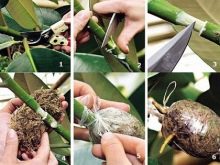
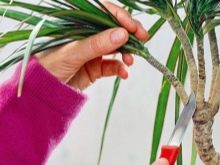
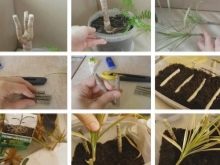
Diseases and pests
Due to the stability of the immune system, dracaena rarely suffers from infectious ailments.If the foliage of the "dragon tree" began to become covered with spots that have a brown or black color, as well as an elongated shape, then the flower is probably infected with Alternaria. With a light brown color of the spots - heterosporosis. If there is a gradual drying out and yellowing of the spots, then the plant is infected with phyllostictosis. When there is a suspicion of a disease, the hostess should immediately isolate the dracaena from other representatives of the flora in order to avoid spreading the infection.
The above diseases of the indoor palm can be easily cured. To do this, it is necessary to process the leaves of the tree with fungicides sold in the flower shop. One of the most dangerous ailments that is difficult to treat is bacteriosis. It is manifested by the appearance of putrefactive spots.
On the advice of specialists, the affected plant should be destroyed.
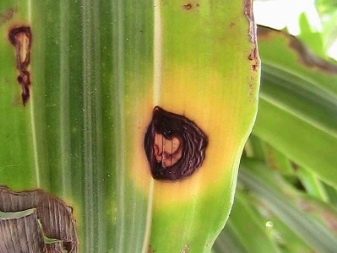
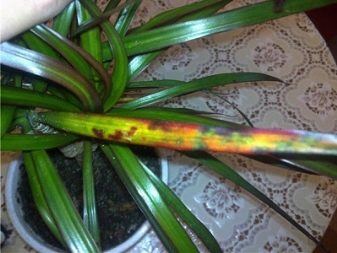
Dracaena is often sick with improper care. When wilting, yellowing of the foliage, you should not be upset, the reason for this may be their natural dying off, which occurs once every 2 years. When young foliage begins to be affected, the reasons for this may be as follows:
- insufficient or excessive lighting;
- improper irrigation;
- lack or excessive amount of nutrients in the soil;
- wrong temperature conditions.
That is why caring for a houseplant should be not only correct, but also regular. Despite its resistance to infectious and bacterial infections, dracaena often suffers from pest attacks. Often it is affected by such parasites:
- mite;
- shield;
- thrips.
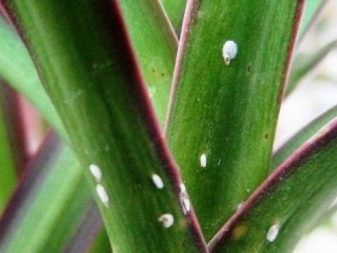

Such parasites have a detrimental effect on the indoor palm and cause a lot of negative consequences. If the plant is attacked by a scale insect, then the foliage withers and its lowering downward. To get rid of a small insect with a brown color, it should be removed with a cloth soaked in soapy water. After that, it is imperative to carry out treatment with an insecticide.
The spider mite causes yellowing of the leaves and the formation of cobwebs on its back. Initially, the foliage should be washed with warm water, and then sprayed with Deris. When a silvery shade appears on the leaves of a room palm, you can see that small black parasites have appeared on their back - these are thrips. To help the house palm, it should be treated with insecticides repeatedly.
Ailments and parasites of the "dragon tree" do not pose an excessive danger, but there will be a lot of troublesome efforts to eliminate them. After buying an indoor flower, each owner should carefully study its features and care rules. If you grow a plant according to all the rules and take timely care, you can get a wonderful living room decoration.
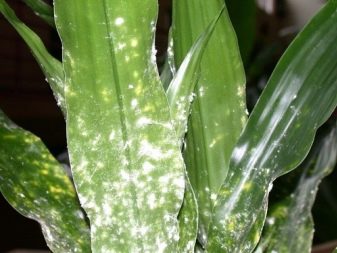
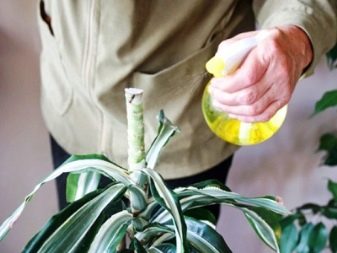
You can learn more about how to take care of Dracena at home.































The comment was sent successfully.